Fourth course at Siam CC set for soft opening
A fourth course at Siam Country Club in Pattaya, Thailand, is set for a soft opening this year. The layout has been designed by Brian Curley and it features a 19-foot-deep bunker complex called the ‘Wall of Death’.
The course, named Rolling Hills, joins the club’s other three layouts – Old course, Plantation and Waterside. Siam CC also has a fifth course in the works, the solo design debut for Toby Cobb, on a site southeast of Bangkok.
“As is the case with all the Siam CC courses, the layout is a ‘core’ design with no real estate element,” said Curley. “This is further enhanced with a generous amount of land dedicated to the design, resulting in a very comfortable and playable feeling for players.
“Like the Old course, the annual site of the Honda LPGA Thailand, there will be an abundance of trees planted to create deep forested framing on some holes and offering desired shade for players and spectators when hosting large events.
“The course differs from the others in its attempt to emulate a more irregular and natural use of turf and bunker lines, transitional bunker edges and mini-fairway tee complexes as opposed to typical individual tees,” continued Curley. “While the course design is far removed from many of the rugged and natural designs in fashion today, it is a bit of a hybrid between formal and natural design, especially with its dominant transitional bunkering edges employing native carpet grass that produce a strong contrast in colour and texture.”
Curley has designed the course to ensure players find their balls. “The large property enabled us to route holes that leave massive areas in between holes, sometimes planted in thickets of trees and sometimes left open in wide corridors for long views,” said Curley. “The result is a widely varied sequence of holes that are easily distinguished and memorable.
“Green sites are quite varied in their design with some at grade, some built up, and some with strong fall away grades. Also incorporated are distinct lobes set in bowls, kick slopes, backstops, and fairway cut surrounds that use gravity to repel wayward shots. I believe the course will be the most distinct of the four layouts and will give the Old course strong competition for favoured status.”
For this project, Curley worked with a sandy site – unusual for inland Thailand – which provided him with areas to harvest material for sandcapping and creating large waste areas. “The material was easily excavated, a great thing since our reservoir was so deep,” said Curley. “Very little native vegetation and trees existed prior to work so we relied on the large earthmove to create big landform movement and a significant planting of surrounds of trees that will grow quickly, given the climate. There was one large interior lake that we incorporated into the routing and main clubhouse view but otherwise the design relied upon a created earthmove, not an integrated design ‘finding’ holes.”
Curley has overseen the reduction of initial turf limits and conversion of rough from turfgrass to native carpet grass, to reduce irrigation demand and conserve water.
“We did deviate from our initial concept to incorporate massive swaths of pine straw-based sandy expanses as it proved too difficult to obtain the pine straw material,” said Curley. “We did, however, keep with large forested areas of casuarina trees as the backbone tree and these will, in a short time, create this bed of pine straw on top of the native carpet grass.
“I was very vocal in the initial design discussions to create unique and recognisable design features that would set the course apart from others in the region. This led to many distinct features like the ‘Wall of Death’ and its 19-foot-deep pit, intending to create a buzz with visiting golfers and lure those up to the challenge.
“I brought up how certain features on certain holes help define the overall experience and, that often these features come with a nickname. Think ‘Hell’s Half Acre’ or the ‘Devil’s Asshole’ at Pine Valley or ‘Hell Bunker’ and the Road Hole at St. Andrews. These are iconic images that create folklore and are especially appealing to the resort golfer looking for a memorable golf round on their travels.
“In the past, I have certainly been associated with wildly different concepts such as the Fantasy course at Mission Hills where plans were to build iconic holes such as the island green, noodle bowl, a ‘Great Wall’ hole, mock excavations site of Terracotta warriors, etc. But while the Fantasy course was intended to be exceptionally over the top and cartoonish as part of a 10-course complex, here we wanted to stay within the realm of reality of a standard golf course.
“It was then that I thought back to one of my first experiences in golf design when I was involved with Pete Dye in the Stadium course at PGA West in La Quinta, California,” continued Curley. “There, Pete convinced the owners at Landmark to construct the massive, 18-foot-deep bunker left of the par-five sixteenth hole. I recalled that the depth was perfect for an opened sand wedge and full swing, recoverable if properly executed but not a simple task. Pete argued that on a typical course, this would likely be a lake with no chance to recover but, here, he would offer that chance. It quickly became known worldwide and was made famous at the Bob Hope Classic when a celebrity politician — speaker of the house, Tip O’Neal — swatted away endlessly on TV.
“Here, we were given the opportunity to create the needed elevation change with the vast amount of dirt we excavated from the reservoir on site. This allowed me to prop the sixteenth green well above while still allowing for the site to drain. I also wanted to create a doubled series of railroad ties, something I had never seen done before.
“Unlike the PGA West bunker that is placed right against the green edge, this wall is offset from the green edge by about five-to-six metres, making the recovery even more difficult as you must not only ‘elevate’ but also ‘propel’ the ball forward.
“The ‘railroad ties’ are actually 2.5 metres long concrete sections, sculpted and stained to look like ties buried about a half metre. There is a significant concrete formed curb that holds the upper layer in place to avoid any shifting. The upper wall is almost vertical while the lower wall has more pitch to it to avoid a player drilling the ball back into his or her face. There is a short offset set between the two — in case someone was to stumble from the top — and the bunker slope has a strong flashed slope. The carpet grass surfaces are mowed tight to ensure that no balls hold up on the slope and all make it down to the bottom. There is some vegetation planted on the wall as well — some Bougainvillea and cascades of wedelia — to add to the unique look.
“I do believe there is great variety from hole to hole and features seldom seen in Asian courses, especially the Thai market.”
This article is based on material that first appeared in the October 2019 issue of Golf Course Architecture. For a printed subscription or free digital edition, please visit our subscriptions page.
| Slideshow HTML |
-
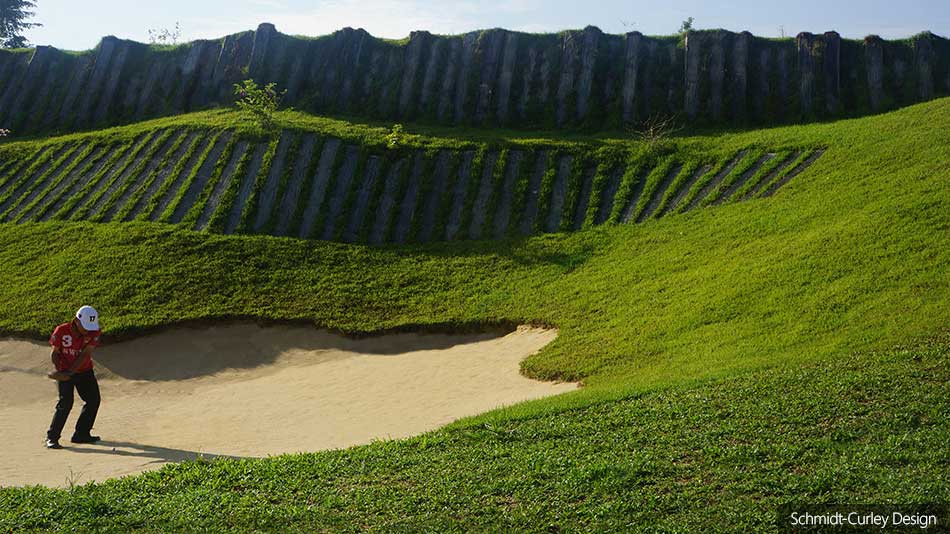
A fourth course at Siam Country Club, designed by Brian Curley, is set for a soft opening this year
-
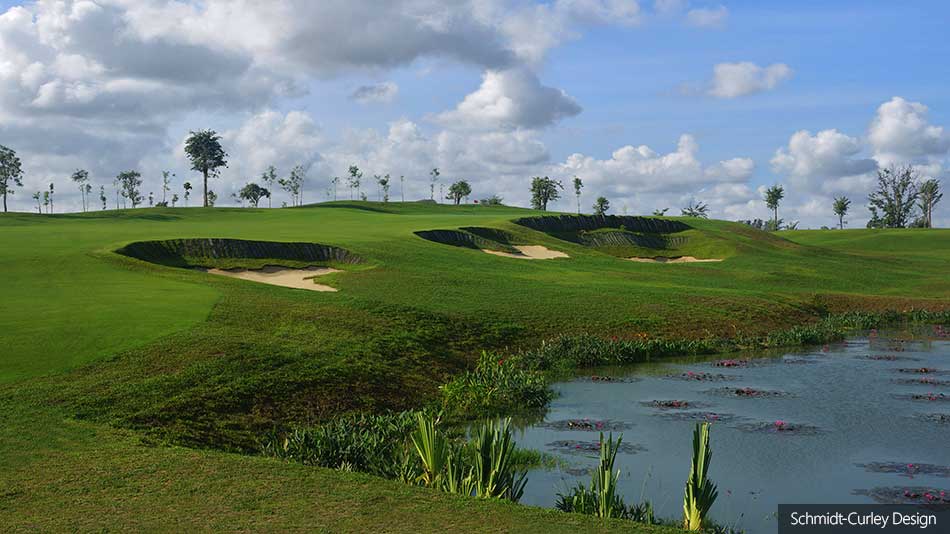
The par-five fifteenth at Rolling Hills features a 19-foot-deep bunker complex named the ‘Wall of Death’
-
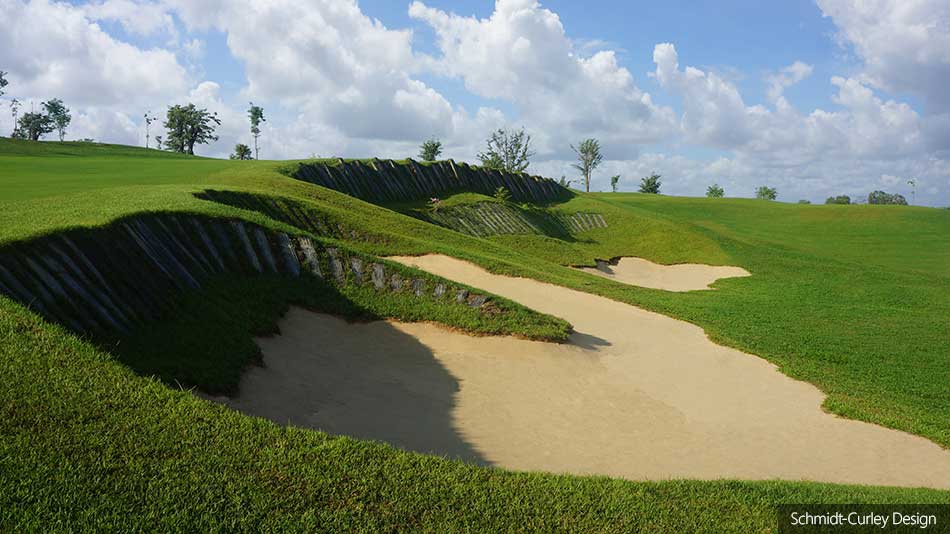
Curley aims “to create a buzz with visiting golfers and lure those up to the challenge” with the Wall of Death
-

“Green sites are quite varied in their design with some at grade, some built up, and some with strong fall away grades,” says Curley
-
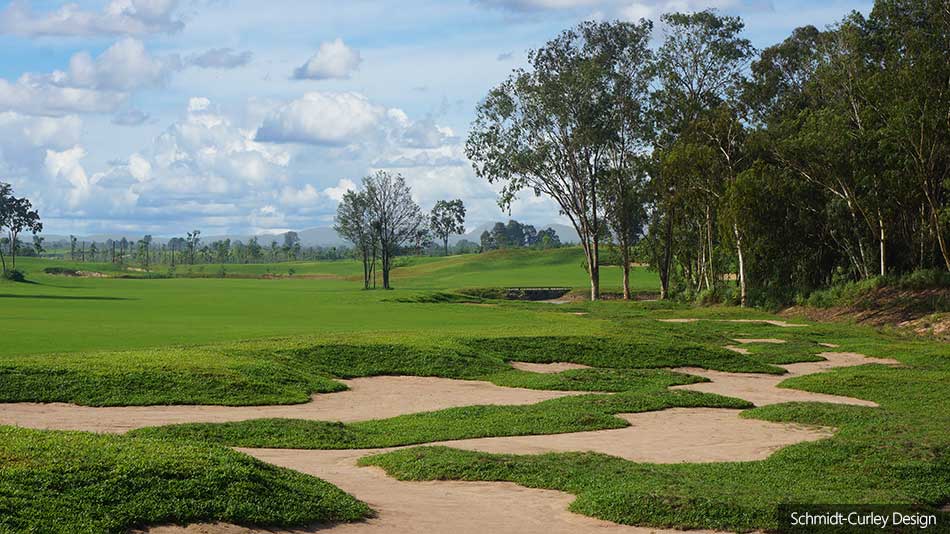
A significant number of trees were planted to frame some holes and shade golfers
-
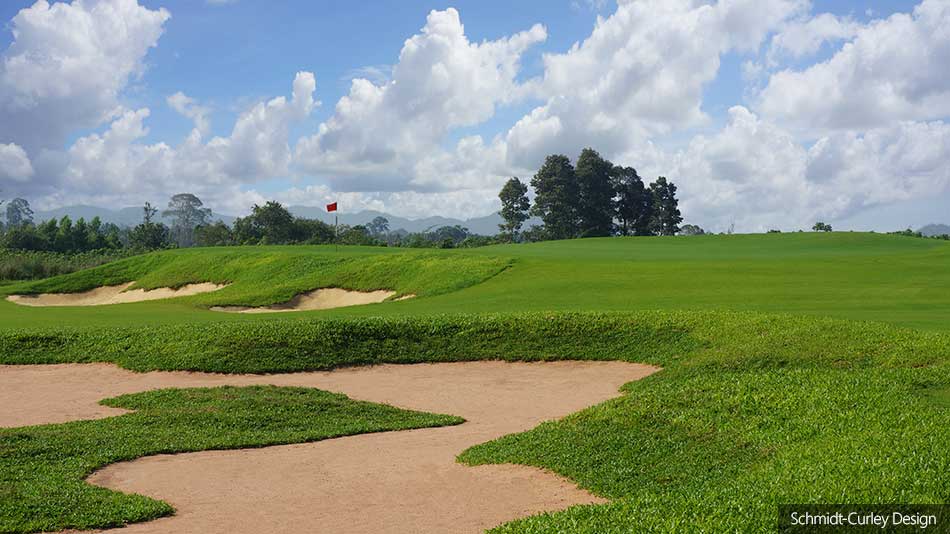
The course features transitional bunker edges which contrast with the native carpet grass
-
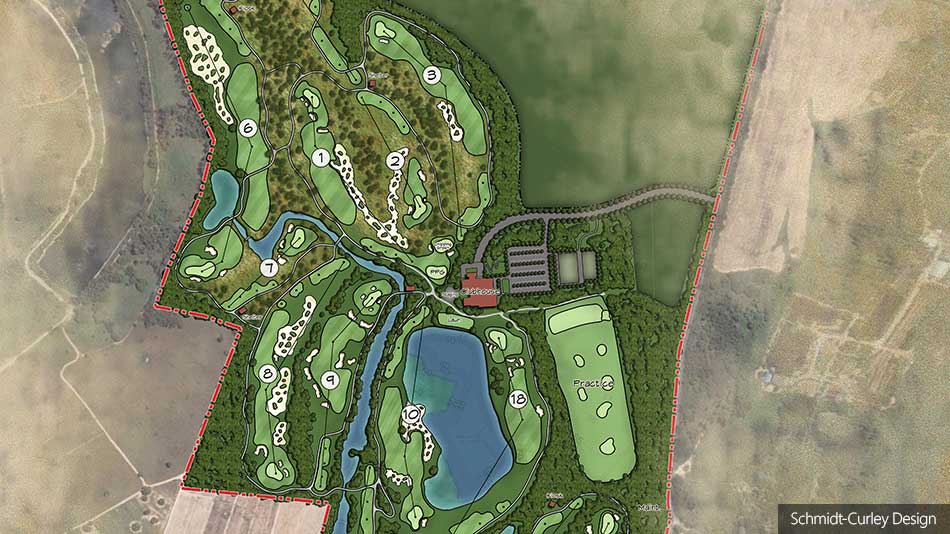
A large interior lake was incorporated into the routing
|